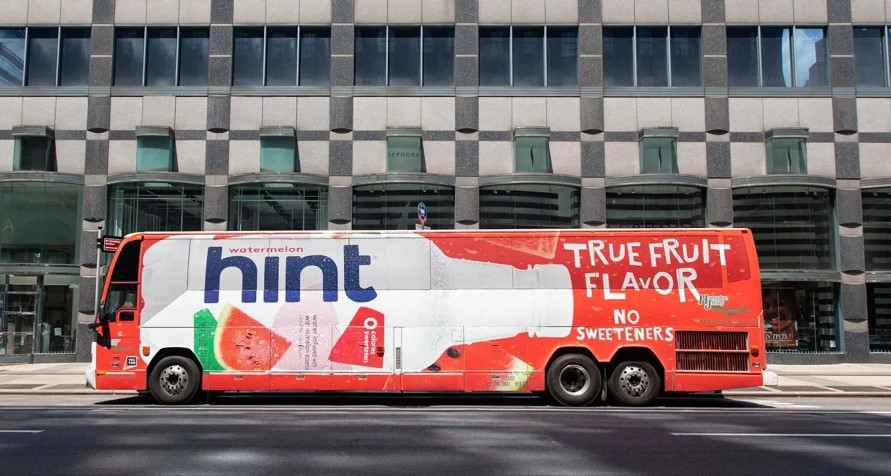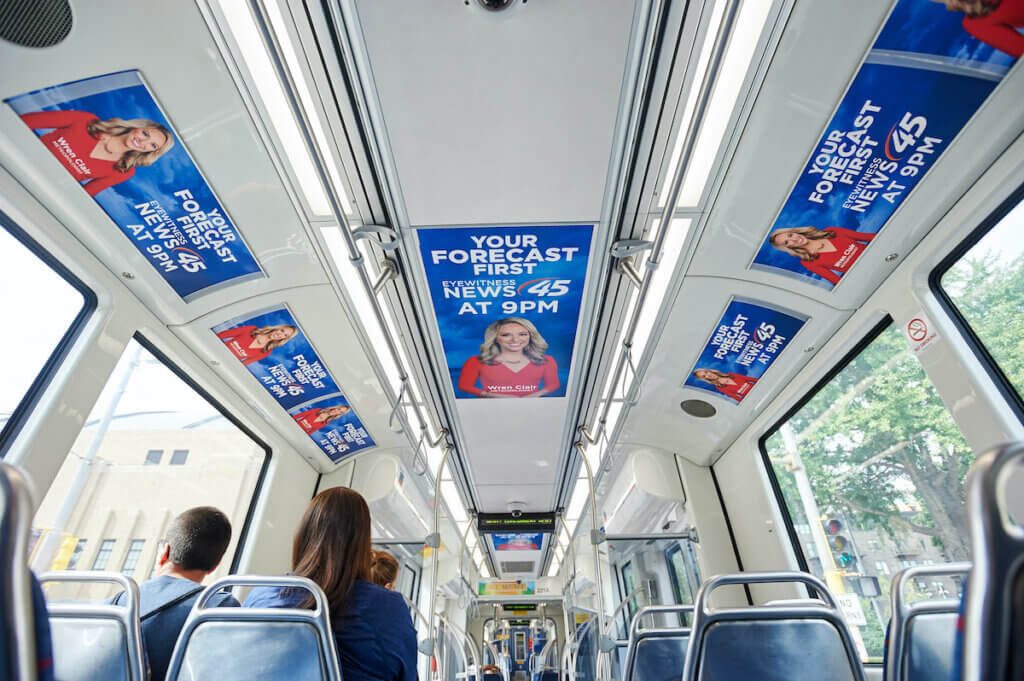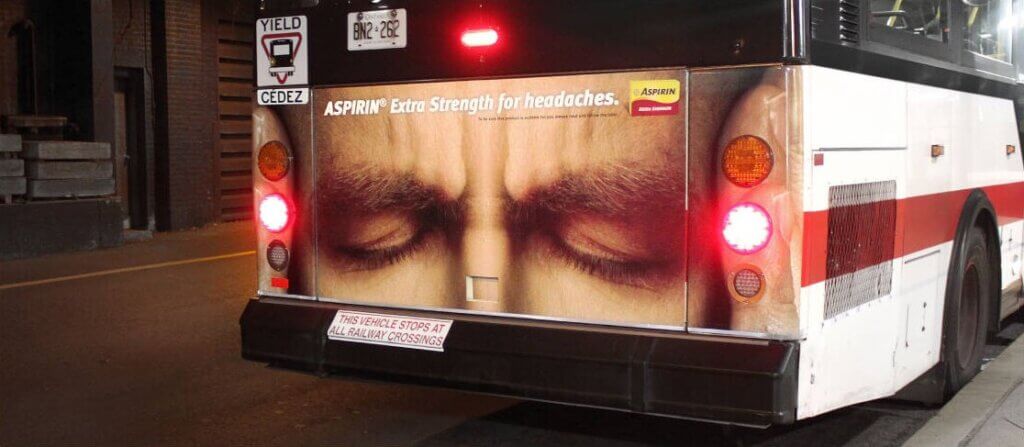
When it comes to advertising, the key is to be where your audience is. Traditional advertising channels often struggle to keep pace with the fast-paced rhythms of modern society. So, in a world where people are constantly on the move, transit advertising offers a unique opportunity for local businesses to connect with potential customers. By strategically placing advertisements on buses, trains, and other modes of transportation, businesses can reach a captive audience during their daily commutes.
In this blog, we’ll explore the transformative power of transit advertising and how it can serve as a medium for local businesses to thrive in their communities. But first,
Understanding Transit Advertising
Transit advertising is a dynamic marketing strategy that leverages various mediums, from sleek bus wraps to eye-catching subway posters, strategically positioned within public transportation networks to captivate the attention of commuters on their daily journeys. These ads ensure maximum exposure for businesses seeking to connect with their target audience on the go.
Few formats of Transit Advertising
Bus Wraps
Entire buses are covered with large advertisements, transforming them into mobile billboards that provide businesses with a moving canvas to showcase their brand and message. By completely covering the exterior of buses with branded graphics, images, and messaging, bus wraps create a moving billboard that commands attention and generates widespread brand visibility. Bus wraps offer ample creative flexibility, allowing advertisers to showcase eye-catching designs and capture the imagination of commuters and pedestrians alike.

Subway Posters
Posters are displayed inside subway cars and on station platforms, providing businesses a captive audience to convey their message. These posters are strategically placed in high-traffic areas within transit stations, such as platforms, entrances, and concourses, ensuring maximum exposure to commuters waiting for trains, buses, or subway services. Transit station posters offer a cost-effective way to reach a captive audience and deliver brand messaging in a targeted and impactful manner.

Train Wraps
Similar to bus wraps, train wraps involve covering entire train cars with large vinyl advertisements. These moving billboards offer extensive exposure on commuter rail lines and subway systems, reaching a wide audience of passengers during their daily travels. With vibrant graphics, bold colors, and compelling messaging, train wraps create an unmissable presence that extends far beyond the confines of transit stations and tracks.
Taxi Advertising
Taxis serve as mobile advertising platforms, reaching passengers and pedestrians as they navigate city streets. With ads displayed both inside and outside vehicles, taxi advertising delivers messages directly to consumers on the move, ensuring maximum exposure in urban environments.
Street Furniture
Street furniture advertising encompasses a variety of formats, including bus shelters, benches, kiosks, and information panels located at transit stops and high-traffic pedestrian areas. These advertising displays provide a visible and accessible platform for advertisers to showcase their brand messaging to commuters and pedestrians passing by.
Strategies for Maximizing Transit Advertising Impact
In order to maximize the impact of transit advertising, businesses must go beyond simply placing ads on vehicles or in stations, they must craft compelling campaigns that captivate and engage their target audience.
Know your audience
Before launching the transit advertising campaign, consider demographics such as age, gender, income level, and interests, as well as psychographics such as lifestyle, values, and preferences. The more you know about your audience, the better equipped you’ll be to create targeted and relevant ads that resonate with them.
Consider Commuter Behaviors
Study the behaviors and habits of your target audience. Are they regular users of public transportation, or do they prefer to drive? What times of day do they commute, and which transit routes do they frequent? By analyzing commuter behaviors, you can optimize your targeting strategy to ensure that your ads are seen by the right people at the right time and place.
Define your objectives
Are you looking to increase brand awareness, drive foot traffic to your store, or promote a specific product or service? By identifying your objectives upfront, you can tailor your targeting strategy to align with your overarching goals and measure the success of your campaign more effectively.
Clear Messaging
Craft compelling and relevant ad copy that speaks directly to their needs, desires, and pain points. Whether it’s highlighting the benefits of your product or service, promoting a limited-time offer, or sparking curiosity with a catchy slogan, make sure your messaging speaks to your audience’s interests and motivations.
A/B Test Your Messaging
Experiment with different messaging variations, creative elements, and calls-to-action to determine what resonates most with your audience. Conduct A/B tests to compare the performance of different ad creatives and refine your messaging based on real-time feedback and insights.
Technology’s Impact on Transit Advertising

As technology continues to evolve, transit advertising offers businesses new opportunities to engage consumers with innovative and interactive experiences. By incorporating interactive elements into ads, businesses can create immersive experiences that leave a lasting impression on commuters and maximize ROI.
Precision Targeting
Technology enables businesses to leverage advanced targeting capabilities to reach their desired audience with precision and accuracy. Through sophisticated data analytics and geo targeting techniques, businesses can ensure that their transit ads reach the right people at the right time, maximizing the impact of their advertising efforts. Geotargeting, for example, allows businesses to deliver ads to commuters based on their geographic location, ensuring maximum relevance and resonance with the target audience.
Dynamic and Interactive Content
Digital signage and displays have transformed static ads into immersive experiences that capture attention and drive engagement. Digital displays on buses, trains, and in transit stations allow businesses to deliver engaging and immersive content that captures the attention of commuters. From vibrant LED screens to interactive touchscreens, these technologies enable businesses to convey their message in a more impactful and memorable way.
Immersive Experiences through AR
Augmented reality (AR) technology is revolutionizing the way commuters interact with transit ads, transforming static advertisements into immersive experiences. AR-enabled smart glasses or mobile apps overlay digital content onto the physical world, allowing commuters to interact with virtual objects and experiences in real-time.
Real-Time Optimization
Technology facilitates real-time campaign management, allowing businesses to monitor and optimize their transit advertising campaigns. With the advent of programmatic advertising platforms, businesses can monitor key performance indicators such as impressions, clicks, and conversions, businesses can make data-driven decisions to adjust targeting parameters, creative content, and budget allocations on the fly, ensuring maximum efficiency and effectiveness.
What are the benefits?
Wide-reaching Audience
One of the primary benefits of transit advertising lies in its ability to reach a vast and diverse audience. Whether it’s commuters on buses, trains, or subway platforms, transit ads have the ability to capture the attention of individuals from various demographics, ensuring widespread exposure and brand visibility.
Geographic Targeting
With transit advertising, brands have the opportunity to strategically target specific geographic areas and routes where their target audience resides or frequents. By strategically selecting transit routes that align with target demographics and geographic areas of interest, businesses can effectively reach and engage with local audiences, driving foot traffic and brand awareness in key markets.
Cost-effectiveness
Transit advertising is cost-effective, offering businesses with limited marketing budgets an affordable solution to increase brand visibility and awareness. With a variety of pricing options available, businesses can choose the transit advertising strategy that best aligns with their financial goals. Whether it’s a small shop looking to attract new customers or a startup seeking to establish a foothold in the market, transit advertising offers a cost-effective and impactful solution for businesses of all sizes and industries.
Continuous Exposure
Transit ads provide brands with continuous exposure to consumers throughout their daily journeys. Whether it’s commuters on buses, trains, or subway platforms, transit ads have the power to captivate the attention of individuals from all walks of life, delivering brand messaging to a broad demographic spectrum.
Captive Audience
Unlike other forms of advertising that can be easily ignored or skipped, transit advertising captures the attention of a captive audience. Unlike other forms of advertising that can be easily ignored or skipped, transit advertising captures the attention of a captive audience.
Evaluating ROI for Transit Advertising
Tracking Brand Awareness
A fundamental aspect of measuring ROI on transit advertising is tracking brand awareness metrics before, during, and after the campaign. Implementing surveys, polls, or interactive elements in transit ads can encourage commuters to provide real-time feedback on their impressions of the campaign. Analyzing qualitative data such as consumer sentiments, reactions, and anecdotes can offer valuable insights into the effectiveness of transit ads in resonating with the target audience.
Monitoring Digital Engagement
Monitoring digital engagement metrics such as click-through rates, website visits, social media interactions, and app downloads can provide tangible indicators of the impact of transit advertising on driving online engagement and conversions. Integrating digital tracking mechanisms into transit ads enables advertisers to measure ROI more comprehensively and accurately.
Calculating Reach and Impressions
Transit agencies often provide data on the number of vehicles, routes, and passengers reached by ad placements, allowing advertisers to estimate the potential exposure of their campaigns. Additionally, digital displays and tracking technologies can provide real-time insights into the number of views and engagements generated by transit ads.
Assessing Cost-Effectiveness
Another critical aspect of measuring ROI on transit advertising is assessing cost-effectiveness relative to other marketing channels. By comparing the cost per thousand impressions (CPM) or cost per acquisition (CPA) of transit advertising against alternative advertising mediums, advertisers can evaluate the efficiency and value of their investment.
The Significance of Transit Advertising in Marketing
Unmatched Reach and Exposure
Transit advertising offers unparalleled reach and exposure, ensuring that brand messaging is seen by millions of eyes each day. Whether it’s through bus wraps, train station posters, or digital displays in transit vehicles, transit ads have the ability to capture the attention of commuters, pedestrians, and motorists in urban, suburban, and rural areas alike.
Mobile and Dynamic Brand Presence
Whether it’s wrapping buses and trains with eye-catching graphics or installing digital screens inside transit vehicles, transit ads create a moving canvas that travels through city streets, neighborhoods, and commercial districts, ensuring that brands remain visible and relevant in the urban landscape. This mobile brand presence enables brands to reach consumers where they live, work, and play, driving top-of-mind awareness and fostering long-lasting brand connections.
Targeted Audience Engagement
Transit advertising enables brands to engage with audiences on a hyper-local level, reaching consumers in specific geographic areas, neighborhoods, or transit routes. By strategically selecting transit placements that align with their target market, brands can deliver customized messages that resonate with local audiences, driving brand awareness and loyalty within their communities.
Amplified Impact of Out-of-Home Advertising
Transit advertising complements and amplifies the impact of out-of-home advertising strategies, extending brand reach beyond traditional advertising mediums. By integrating transit ads with outdoor billboards, digital signage, and experiential marketing activations, brands create cohesive and immersive brand experiences that connect with consumers in both physical and digital spaces, driving brand affinity and loyalty.
Transit advertising plays a vital role in the marketing mix. By leveraging the unique advantages of transit advertising, brands can enhance their visibility, engagement, and influence in today’s dynamic and competitive marketplace.
Case Studies
Aspirin Bus Ad “Headache”
Aspirin Pharmaceuticals sought to increase brand awareness and drive consumer engagement through a creative transit advertising campaign. The campaign concept centered around the idea of a visually compelling and relatable representation of a headache. Through a strategic partnership with transit authorities, Aspirin ads were wrapped on the backs of buses citywide. As buses braked, the back lights lit up to highlight the throbbing pain.
In a city where traffic congestion is a daily reality, the “Headache” campaign struck a chord with commuters, positioning Aspirin as the go-to solution for fast and effective pain relief in the midst of life’s daily struggles.

Conclusion
Transit advertising represents a powerful and versatile tool for local businesses seeking to elevate their visibility and connect with their target audience in today’s fast-paced world. By leveraging various formats and placements within public transportation networks, businesses can increase their visibility, target specific demographics, and effectively communicate their message to potential customers on the move. Whether it’s a bold bus wrap that turns heads on city streets or a strategically placed subway poster that captures the attention of commuters, transit advertising offers businesses a cost-effective and impactful solution for reaching their marketing goals and driving long-term growth in their local communities.


